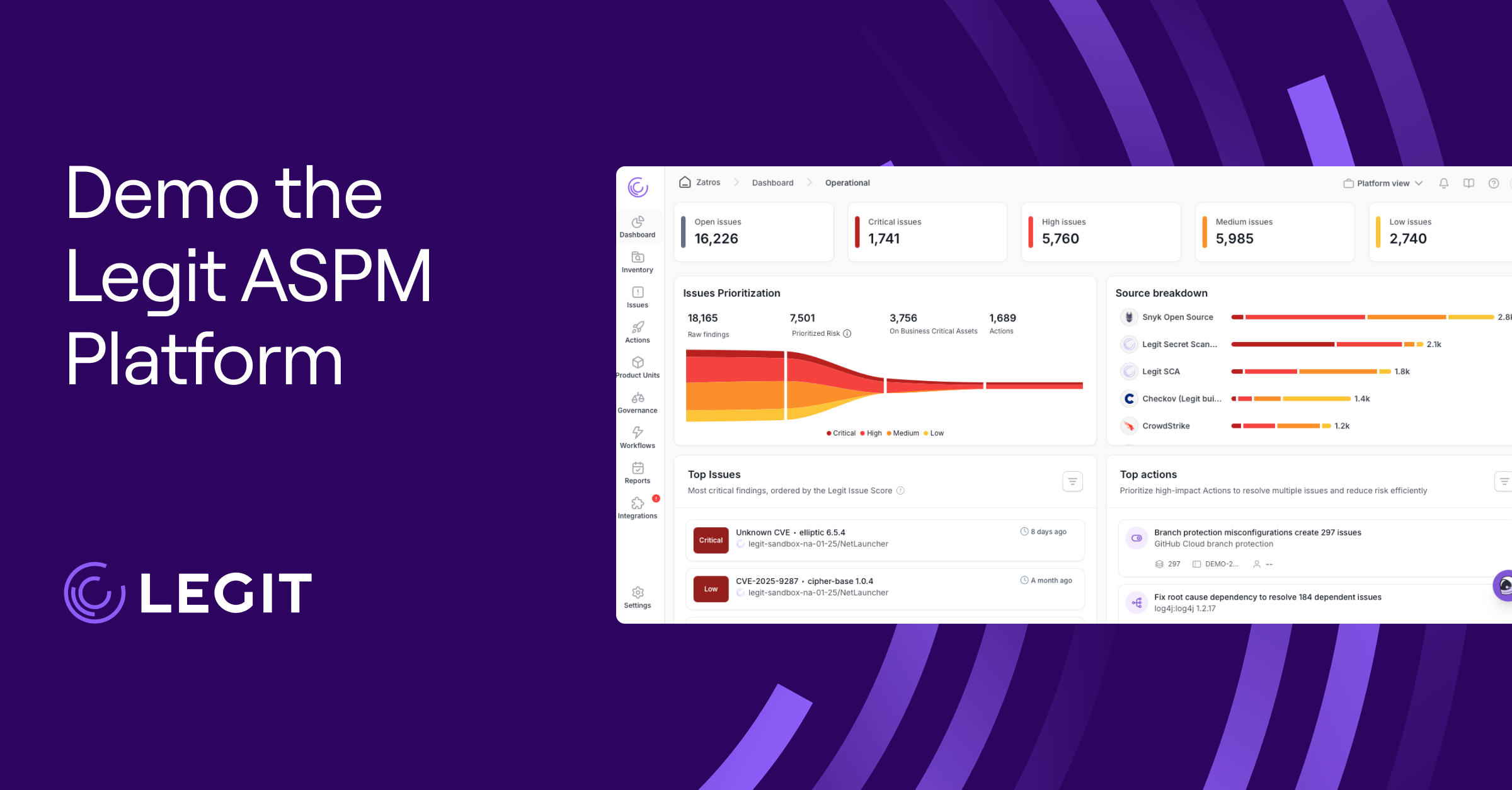Imagine building a house brick by brick only to find out some bricks were faulty. One weak point puts the entire structure at risk, and it takes time and effort to redo what went wrong.
In the software world, those bricks are the components of your software supply chain—from source code to build pipelines to third-party tools and code. Weak links make the whole supply chain vulnerable, especially when it comes to security. Each component in the software development lifecycle (SDLC) needs to be airtight.
Here’s a guide to what the software supply chain is and how to defend it at every stage of the process.
What Is the Software Supply Chain?
The software supply chain is the collection of processes, tools, and components that work together to create and maintain software. Think of it as a factory assembly line. Raw materials such as code and dependencies go in, and the final product—your software—comes out ready for users.
Let’s say you’re building an e-commerce platform. You write the core functionality for processing payments and managing products and use third-party tools for other features, like shipping calculations or customer reviews. After that, you test and package the software for release before deployment. Every one of these stages is a vital component of software supply chain management.
Key components of software supply chains include:
- Core code development: This is the backbone of your software, where developers write and manage the primary codebase.
- Third-party tools and libraries: External software components extend functionality without requiring you to reinvent the wheel. You use code and tools, such as payment gateways or authentication services, that have already been developed to save time and money.
- Build and package assembly: This is the process of compiling and packaging the software for release.
- Delivery channels: Delivery channels are the platforms and mechanisms that distribute the software to users, whether through app stores, cloud repositories, or websites.
- Hosting and infrastructure: Physical or cloud-based environments, such as cloud servers or on-premises data centers, host the software.
- Continuous monitoring and upkeep: Always monitor software performance. This includes applying updates, patches, and bug fixes to maintain stability and security.
Why Is Software Supply Chain Security Important?
The modern SDLC relies on various components, and a vulnerability in any of them could lead to a significant compromise. A common misconception is that supply chain risk only entails third-party components, but internal code, servers, and tools are just as susceptible. This means you have to consider security risks at every stage in the development process—and to do that, you need a robust understanding of the supply chain and each component’s security needs.
Why Does the Software Supply Chain Become Vulnerable?
Here are some of the most common reasons the software supply chain becomes susceptible to attacks:
1. Secrets Exposure
The SDLC is full of confidential data like API keys, passwords, and certificates—also known as secrets. Without proper secrets management, attackers can access this data and use it as an entry point to important services, helping them infiltrate systems, exfiltrate data, or move laterally within your network.
2. Misconfiguration of Build Assets
Build pipelines, such as those used in continuous integration and continuous delivery (CI/CD) processes, involve many moving parts. A single misconfiguration—like leaving a server port open, failing to properly restrict access, or incorrectly setting up permissions—opens the door to bad actors.
Attackers can gain access to critical build systems or inject malicious artifacts into the software. For example, an exposed API endpoint might allow unauthorized CI/CD pipeline access, letting someone manipulate code or deploy unapproved changes. These errors usually go unnoticed until they’re exploited.
3. Infrastructure Vulnerabilities
Infrastructure vulnerabilities arise when servers, cloud environments, and containers aren’t secure. For example, failing to apply security patches can leave known vulnerabilities open for attackers to exploit. These weaknesses give attackers a foothold, allowing them to move laterally through your network, access sensitive data, or disrupt critical services.
4. Third-Party Dependencies
Most software relies on third-party libraries or packages, which could have undetected vulnerabilities. If you use dependencies without regularly scanning for issues, you could introduce risks into your system—even if those dependencies seem secure or are popular options.
5. Codebase Vulnerabilities
Internal code flaws can also lead to security gaps. Whether it’s a lack of proper validation, insecure coding practices, or failure to apply security patches, codebase vulnerabilities make your software an attractive target for attackers.
6. People Vulnerabilities
Humans are often the weakest link in the software supply chain. Mistakes like misconfigured settings or even falling victim to phishing attacks can expose your systems. Additionally, malicious insiders or contractors with access to sensitive parts of the supply chain can intentionally create vulnerabilities for attackers to exploit. Conducting proper training and limiting access to critical systems can help mitigate these risks.
7 Best Practices to Mitigate Software Supply Chain Risks
Securing your software supply chain requires a proactive approach. Following these best practices can reduce risks and protect your software from attacks:
1. Secrets Scanning
Secrets often hide in places you wouldn’t expect, like log files and containers. Scan for secrets across your entire development environment—not just your codebase—to catch these vulnerabilities before someone can exploit them. This minimizes the risk of sensitive data falling into the wrong hands.
Using a robust secrets scanner like Legit Security automates the process and saves you time. Legit Security can detect and remediate secrets throughout your SDLC, alerting you to vulnerabilities as soon as possible. Mitigate breaches and prevent data loss without sacrificing the secrets that help your software run.
2. Least Privilege
Developers and build tools often end up with more access than they need, which increases your attack surface. Keeping permissions tight by only granting access to what’s necessary protects sensitive information like source code and production data. Limiting privilege across projects also minimizes fallout if credentials are exposed.
3. Visibility and Configurations
Misconfigurations often happen during setup or when processes change quickly. Keep tabs on new build assets and pipelines as you create them to get the real-time insights necessary to catch potential misconfigurations early. Secure, pre-configured templates for pipelines and infrastructure—also known as paved pathways—reduce risks while making it easy for developers to follow secure practices.
4. Prioritization
When addressing vulnerabilities, prioritize based on context. Sending developers every small issue will overwhelm them, but focusing only on critical vulnerabilities might cause you to miss high-impact, less obvious ones. The key is to assess risk by considering business impact and exploitability to find the right balance between what needs to be fixed and how fast.
5. SBOM Implementation
A software bill of materials (SBOM) gives you a detailed inventory of all your software's components, libraries, and dependencies. This transparency helps you track and manage vulnerabilities throughout the SDLC and stay ahead of potential security risks.
6. Regular Security Audits
Audit your software development and deployment processes regularly to identify security gaps and misconfigurations before attackers do. By reviewing configurations, permissions, and workflows, you ensure that all systems align with best practices—and if not, you gain valuable insights to tighten your security posture.
7. Ongoing Training
Secure coding and server management are important, but don’t forget about human error. Your team’s actions have huge impacts on security posture. Consistent training keeps everyone aware of potential risks and best practices, preparing your team for evolving threats.
Make sure all team members know how to recognize phishing attempts and avoid newer threats like dependency confusion and namespace attacks. Dependency confusion happens when attackers trick people into downloading malicious packages by exploiting naming overlaps between private and public package repositories. And namespace attacks happen when malicious actors upload harmful code disguised as legitimate software packages.
Protect Your Software Supply Chain With Legit Security
A secure software supply chain maintains your software's integrity and protects your business from evolving cyber threats. And that means staying ahead of emerging attack patterns, vulnerable secrets, and frequent targets.
Integrating Legit Security’s services empowers you to automatically discover, analyze, and secure your end-to-end software supply chain. With real-time insights, automated vulnerability scanning, and comprehensive monitoring, Legit Security offers all the tools you need for a secure SDLC.
Reach out for a demo and see how Legit Security protects the entire software factory.
Download our new whitepaper.


